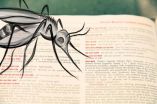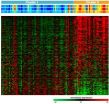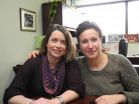(Press-News.org) CHAPEL HILL, NC – Creating a vaccine that protects people from all four types of dengue virus has frustrated scientists for decades. But researchers at the University of North Carolina have discovered a new target for human antibodies that could hold the key to a vaccine for the world's most widespread mosquito-borne disease.
Using an experimental technique new to the dengue field, the labs of Ralph Baric, PhD, and Aravinda de Silva, PhD, showed that a molecular hinge where two regions of a protein connect is where natural human antibodies attach to dengue 3 to disable it. The finding, published in the Proceedings of the National Academy of Sciences, shows that after primary infection most human antibodies that neutralize the virus bind to the hinge region.
It's the first study to demonstrate how these binding sites – composed of just 25 amino acids – can be genetically swapped out for amino acids from another dengue type without disrupting the integrity of the virus.
"This gives us a lot of insight into how human antibodies work," said de Silva, a professor of microbiology and immunology in the UNC School of Medicine. "And there could be a lot of translational aspects to this; it could lead to a new way to create vaccines for other diseases."
De Silva and Baric, a professor with a dual appointment in the UNC School of Medicine and the UNC Gillings School of Global Public Health, are now working with vaccine developers at two pharmaceutical companies to test the effectiveness of potential dengue vaccines now in clinical trials. If these vaccines don't bind to their molecular hinge, then the vaccines will likely prove less effective than researchers would like, especially over time.
Dengue, which infects approximately 390 million people each year, is common in tropical and subtropical regions around the world. There were 63 confirmed cases in the Florida Keys in 2010. The virus, widespread in the United States territory of Puerto Rico, has also been confirmed in mainland south Florida and Texas. "The mosquitos that can carry dengue exist throughout the southeastern United States," Baric said. "It's just a matter of time before dengue virus reemerges in the South, making vaccines and therapeutics a critical long-term public health priority."
Making a truly effective dengue vaccine has proven difficult because of a phenomenon called antibody dependent enhancement. People infected with one type of dengue usually develop a natural immune response that rids the body of the virus and prevents a repeat infection of that same virus type. But if those people are infected with a second type of dengue, the virus is enhanced because of that first immune response. The result can be severe dengue hemorrhagic fever, which can be deadly.
Consequently, a vaccine that offers immunity for only one type of dengue would make other types of dengue more virulent and dangerous. The first large clinical trial of a dengue vaccine, conducted in Thailand in 2011, contained a cocktail of all four types of dengue. But for reasons that remain unclear the vaccine was just partially protective. There was no evidence that the vaccine protected people during a dengue 2 outbreak that same year.
To study dengue, de Silva and colleagues have collected samples from infected Sri Lankans and from Americans who had acquired the disease while abroad. Such samples allowed de Silva's team to find that human antibodies are not the same as mouse antibodies, which had served as the basis for vaccine development. De Silva saw that mouse antibodies latched onto a region of a protein that forms an outer shell of the virus. Human antibodies rarely recognize that region; instead human antibodies bind to a different region where two parts of the outer protein connect. De Silva calls this region an epitope hinge. An epitope is any part of a foreign substance that a human antibody binds to.
To prove the importance of the hinge, de Silva recruited Baric, an expert in pioneering novel ways to manipulate genes in viruses using primarily noroviruses and coronaviruses as models. Using de Silva's dengue expertise and the structure of the dengue virus, Baric was able to pinpoint the structurally complex, nonlinear 25-amino-acid hinge domain and remove it from dengue 3 particles. His group, led by William Messer, PhD, then developed strategies to recover dengue viruses from DNA clones and replace the dengue 3 hinge with a replicated 25-amino-acid chain from dengue 4. Essentially, Baric turned dengue 3 into dengue 4.
The genetically mutated virus survived and grew in cell cultures and in primates. Then the researchers exposed the mutant virus to dengue 3 antibodies, which typically bind to dengue 3. But they had no effect on the genetically modified dengue. They then showed in cell lines that the virus could be neutralized by antibodies directed against dengue 4. In collaboration with researchers at the University of Puerto Rico, de Silva and Baric's team was able to show that the new virus infected primates, which developed antibodies against dengue 4.
"These results amount to a paradigm shift," Baric said. De Silva added, "This told told us that the epitope we thought was important was indeed the main site for antibody binding. If antibodies had been able to bind to other sites on the virus, then we would have seen a small drop in protection against dengue 3." Some antibodies would have bound to those other sites and offered some level of protection. "Instead, we saw a complete loss of protection."
De Silva and Baric are conducting similar experiments with dengue 1 and 3. If they can isolate the major epitopes for each dengue type, then they could potentially genetically modify a virus with all four epitopes. The result could become the basis for a vaccine against all four types.
De Silva and Baric are using their results to study why antibodies bind to a specific epitope but not to other sites. Such information would lend even more insight into how to design effective vaccines.
Also, de Silva and Baric's research could be translated into other fields in need of vaccines. "The general idea is that a complex protein-interaction site can now be moved from one virus to another," de Silva said. For instance, an epitope from a virus like hepatitis C could be moved onto the live virus used in the measles vaccine. This new chimeric virus would simultaneously offer people protection against hepatitis C and measles.
"We might not even need a virus," de Silva added. "We might just need to create the epitope that we know antibodies can bind to. And that would serve as the vaccine."
De Silva and Baric recently obtained NIH funding to continue their pioneering work to solve the decades-old dengue virus vaccine dilemma.
INFORMATION:
Funding for this research came from the NIH as part of the Southeastern Regional Center for Excellence in Biodefense, which is housed at UNC-Chapel Hill.
Brian Messer, PhD, now an assistant professor at the University of Oregon, was a postdoctoral fellow in Ralph Baric's lab during this study and first author of the PNAS paper. Other contributors include Boyd Yount and Scott Royal, both research specialists in Baric's UNC lab, and Rukie de Alwis, a graduate student in Aravinda de Silva's UNC lab.
UNC researchers team up to find new target for dengue virus vaccine
By re-engineering a tiny chain of amino acids in 1 type of dengue virus, Ralph Baric and Aravinda de Silva discover a new path toward solving the dengue vaccine dilemma; the research has the potential to transform vaccine development for other diseases
2014-02-26
ELSE PRESS RELEASES FROM THIS DATE:
Research shows ovulation motivates women to outdo other women
2014-02-26
For approximately one week every month, millions of women change their economic behavior and become more focused on their social standing relative to other women. According to new research from The University of Texas at San Antonio (UTSA) and the University of Minnesota's Carlson School of Management, the ovulatory cycle alters women's behavior by subconsciously motivating them to outdo other women. This research could have important implications for marketers, consumers and researchers.
The researchers conducted three studies, one of which had ovulating and nonovulating ...
New advances in the chronic lymphocytic leukaemia genome
2014-02-26
This news release is available in Spanish. A study led by Dr. Roderic Guigó from the Centre for Genomic Regulation in Barcelona, as part of the Chronic Lymphatic Leukaemia Genome Consortium, has made new advances in the study of this disease. The work, which was published (in print version) last week in the journal Genome Research, scrutinised the functional profile of the genes and mutations associated with leukaemia.
The Spanish Chronic Lymphatic Leukaemia Genome Consortium had previously identified the principal mutations involved in the development of the disease. ...
Kessler Foundation researchers study factors affecting self-reporting among people with TBI
2014-02-26
West Orange, NJ. February 26, 2014. Kessler Foundation researchers have found that among individuals with TBI, depression and self-awareness affect subjective reports of memory, quality of life (QOL), and satisfaction with life. The study was published in the February 2014 issue of Brain Injury. (Yael Goverover, Nancy D. Chiaravalloti: The impact of self-awareness and depression on subjective reports of memory, quality- of-life and satisfaction with life following TBI. (doi:10.3109/02699052.2013.860474)
Impairment in self-awareness (the ability to accurately recognize ...
Nanoscale freezing leads to better imaging
2014-02-26
It's an odd twist. For scientists to determine if a cell is functioning properly, they must destroy it.
This is what happens in X-ray fluorescence microscopy when biological specimens are exposed to ionizing radiation, which provides images with a level of detail that conventional microscopes just can't match. This exposure can change what is being imaged in profound ways, possibly giving false accounts of how the cell actually works.
To address this issue, researchers at the U.S. Department of Energy's (DOE) Argonne National Laboratory created a new probe that freezes ...
Screen some patients with acute pancreatitis for pancreatic cancer, SLU researchers suggest
2014-02-26
ST. LOUIS – In a study published in Clinical Gastroenterology and Hepatology, Saint Louis University researchers have found a link between acute pancreatitis (inflammation of the pancreas) and pancreatic cancer, a finding which may eventually lead to some pancreatic cancers being detected earlier.
Principle investigator Banke Agarwal, M.D., associate professor of gastroenterology and hepatology at Saint Louis University, says the study builds on earlier research suggesting a connection between the two illnesses.
"Our study demonstrates that there is a much higher ...
Photopharmacology: Optoswitches turn pain off and sight on
2014-02-26
Photoreactive compounds developed by scientists of Ludwig-Maximilians-Universitaet (LMU) in Munich directly modulate nerve-cell function, and open new routes to the treatment of neurological diseases, including chronic pain and certain types of visual impairment.
All modes of sensory perception are based on communication between nerve cells. Both the response to the primary stimulus and the transmission of the resulting signal depend on the function of specialized receptor proteins that are associated with the surface membranes of neurons. Many sensory neurons respond ...
Researchers trap moths with plant-produced sex pheromone
2014-02-26
MANHATTAN, Kan. — A collaborative experiment involving a Kansas State University biochemist may mark the beginning of an effective, environmentally friendly plant-based method of insect control.
Timothy Durrett, assistant professor of biochemistry and molecular biophysics, was part of the collaboration that used various plant and moth enzymes to engineer plants that emitted sex pheromones that mimic those naturally produced by two species of moths.
The research recently appeared in the journal Nature Communications, "A plant factory for moth pheromone production." The ...
Uninsured parents don't take breastfeeding classes, even though breast is best
2014-02-26
ANN ARBOR, Mich. – Just 12 percent of parents without insurance coverage take breastfeeding support classes that can offer crucial support and encourage new moms to breastfeed, according to a new University of Michigan C.S. Mott Children's Hospital National Poll on Children's Health.
The American Academy of Pediatrics recommends exclusively breastfeeding until babies are 6 months of age followed by breastfeeding in combination with the introduction of complementary foods until at least 12 months of age. However, only about half of moms in the US are still breastfeeding ...
Finding a few foes among billions of cellular friends
2014-02-26
Beating cancer is all about early detection, and new research from the University of South Carolina is another step forward in catching the disease early. A team of chemists is reporting a new way to detect just a handful of lurking tumor cells, which can be outnumbered a billion to one in the bloodstream by healthy cells.
The researchers have constructed an ultrasensitive nanoprobe that can electrochemically sense as few as four circulating tumor cells, and it doesn't require any enzymes to produce a detectable signal.
"That makes it a very robust system," says Hui ...
ETC International College's English Plus Courses Helping Students Learn Other Activities
2014-02-26
ETC International College, that has been helping students to improve their English Language Skills for Business and other areas since 1989, now adds English Plus Courses to its curriculum. By enrolling onto these courses, students can learn and improve other areas of their interests along with General or Business English skills.
The current range of Plus courses available at the Bournemouth-based Language Training Center are: English plus tennis, horse riding, dancing, golf, photography, and alternative therapies.
"We realize that, apart from learning English, ...
LAST 30 PRESS RELEASES:
Heart-brain connection: international study reveals the role of the vagus nerve in keeping the heart young
Researchers identify Rb1 as a predictive biomarker for a new therapeutic strategy in some breast cancers
Survey reveals ethical gaps slowing AI adoption in pediatric surgery
Stimulant ADHD medications work differently than thought
AI overestimates how smart people are, according to HSE economists
HSE researchers create genome-wide map of quadruplexes
Scientists boost cell "powerhouses" to burn more calories
Automatic label checking: The missing step in making reliable medical AI
Low daily alcohol intake linked to 50% heightened mouth cancer risk in India
American Meteorological Society announces Rick Spinrad as 2026 President-Elect
Biomass-based carbon capture spotlighted in newly released global climate webinar recording
Illuminating invisible nano pollutants: advanced bioimaging tracks the full journey of emerging nanoscale contaminants in living systems
How does age affect recovery from spinal cord injury?
Novel AI tool offers prognosis for patients with head and neck cancer
Fathers’ microplastic exposure tied to their children’s metabolic problems
Research validates laboratory model for studying high-grade serous ovarian cancer
SIR 2026 delivers transformative breakthroughs in minimally invasive medicine to improve patient care
Stem Cell Reports most downloaded papers of 2025 highlight the breadth and impact of stem cell research
Oxford-led study estimates NHS spends around 3% of its primary and secondary care budget on the health impacts of heat and cold in England
A researcher’s long quest leads to a smart composite breakthrough
Urban wild bees act as “microbial sensors” of city health.
New study finds where you live affects recovery after a hip fracture
Forecasting the impact of fully automated vehicle adoption on US road traffic injuries
Alcohol-related hospitalizations from 2016 to 2022
Semaglutide and hospitalizations in patients with obesity and established cardiovascular disease
Researchers ‘listen in’ to embryo-mother interactions during implantation using a culture system replicating the womb lining
How changing your diet could help save the world
How to make AI truly scalable and reliable for real-time traffic assignment?
Beyond fragmented markets: A new framework for efficient and stable ride-pooling
Can shape priors make road perception more reliable for autonomous driving?
[Press-News.org] UNC researchers team up to find new target for dengue virus vaccineBy re-engineering a tiny chain of amino acids in 1 type of dengue virus, Ralph Baric and Aravinda de Silva discover a new path toward solving the dengue vaccine dilemma; the research has the potential to transform vaccine development for other diseases








